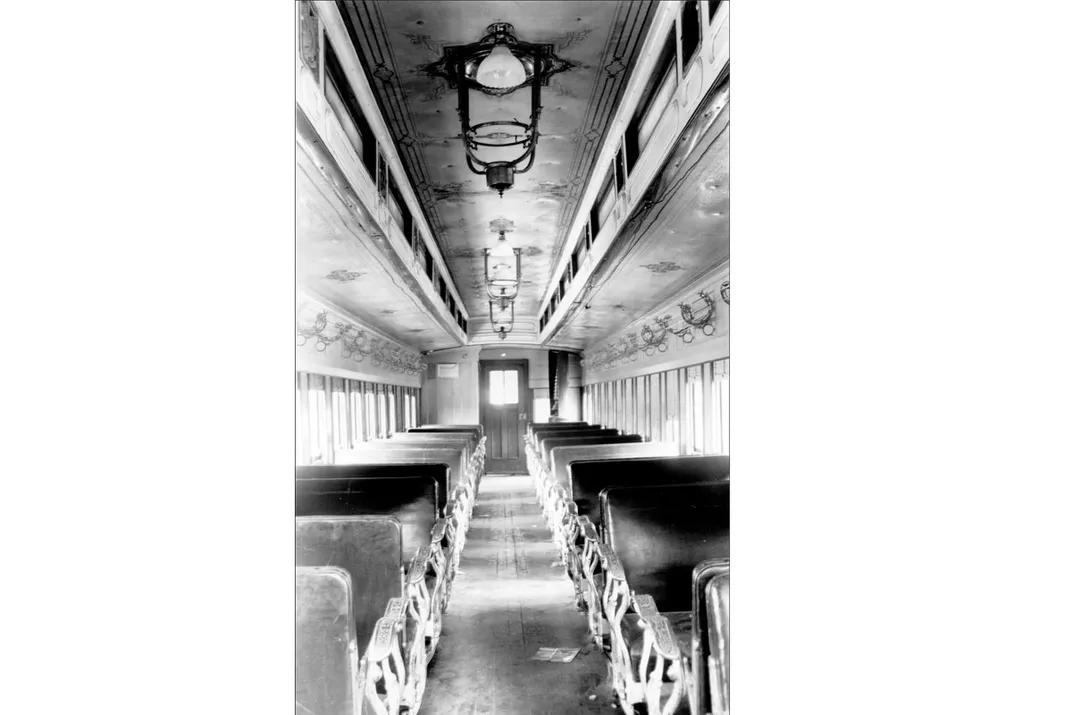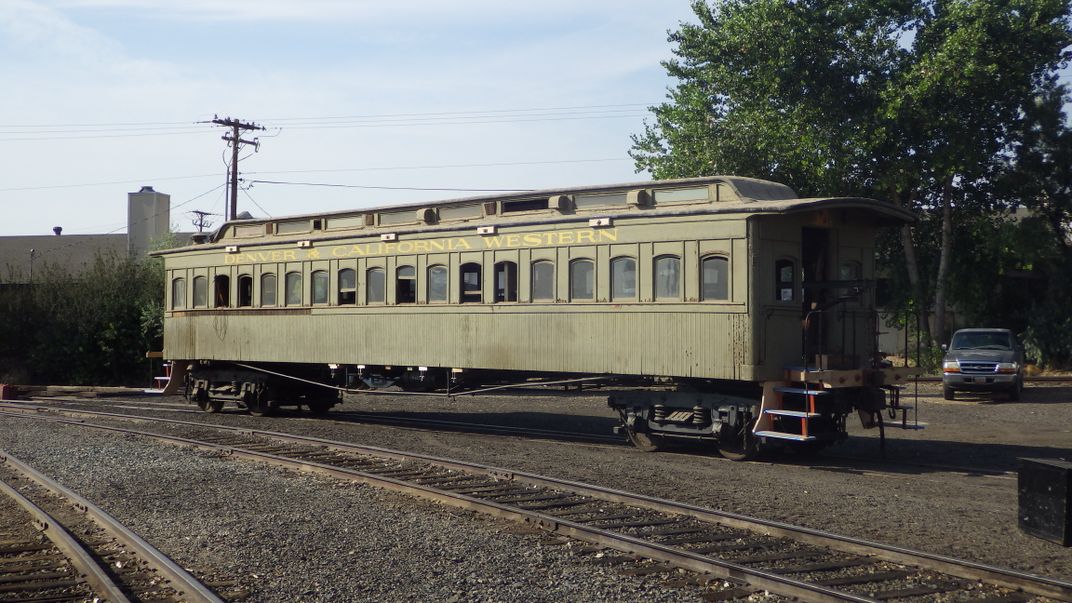The Last Remaining Rail Car That ‘Witnessed’ the Transcontinental Railroad’s Momentous Day
‘Crocker’s Car’ brought the tycoon Leland Stanford to connect the East Coast to the West in 1869
/https://tf-cmsv2-smithsonianmag-media.s3.amazonaws.com/filer/12/93/1293df16-6aaa-4dc3-ad6c-0884bce5cfda/1869_may_9_heading_to_promontory_alfred_a_hart_photo.jpg)
After many years of workers laying mile after mile of track, the Union Pacific and Central Pacific Railroads met on May 10, 1869, at Promontory Summit, Utah, merging into one impossibly long pathway cutting across the United States.
The 1,000 or so spectators who cheered on the historic coupling are long gone, but one important witness remains: the Central Pacific railcar that delivered company president Leland Stanford to the summit, likely along with the ceremonial gold and silver spikes. After a long and winding history, that car is now the centerpiece of an exhibition at the Nevada State Railroad Museum in Carson City that commemorates 150 years since the transcontinental railroad’s completion.
Aside from the spikes, which now belong to Stanford University and the Museum of the City of New York, this car may well be the last mostly intact relic from that transformative moment, says Wendell Huffman, a history curator at the museum and author of a booklet about the car’s history. Written evidence shows that the companies eventually scrapped the locomotives, and Huffman says it’s “pretty conclusive” that the few other cars present for the ceremony have also been lost over the years. (Another railroad car from the time, which stopped at Promontory in the midst of making the first full rail trip from east to west, survives, but has been converted into a wine shop in California.)
“It's easier to tell a story to somebody when they can see something that's part of that story,” Huffman says. “I want someone to be able to touch a piece of that car that was actually back there—because no one's going to let them touch the gold spike.”
The story preserved in this railcar is one of fierce competition and struggle. President Abraham Lincoln signed the Pacific Railway Act into law in 1862, giving two railroad companies the green light to build their tracks inland—the Central Pacific heading east from Sacramento and the Union Pacific working its way west from Omaha, Nebraska. Since the government doled out land and cash for each mile of track laid, the companies set off on a seven-year construction race that culminated in the Promontory Summit meeting.
Central Pacific executive Charles Crocker ordered the car’s construction in 1868 to transport and house the government inspectors who were monitoring the railroad’s progress. The car was built to be luxurious—after all, it was important to keep inspectors happy, Huffman says. Crocker later used the car as his personal coach, earning it the name “Crocker’s Car” or “The Commissioner’s Car.”
At about 50-feet long, the car could hold a dozen passengers in relative comfort and was divided into various rooms, including a parlor, a bedroom, a kitchen and a tiny bathroom.
When it came time for Stanford and other Central Pacific officials to head from Sacramento to Utah for the big day, they piled into Crocker’s Car, which, along with a baggage car, was delivered to Promontory Point by the since-destroyed locomotive Jupiter.* They carried with them four railroad spikes created for the occasion: a silver spike dedicated by the state of Nevada; a gold-and-silver blend presented by Arizona; a gold spike (which has since been lost) presented by a San Francisco newspaper proprietor; and the iconic Golden Spike, engraved with names, dates and the patriotic message, “May God continue the unity of our Country as this Railroad unites the two great Oceans of the world.”
Once Stanford drove in that Golden Spike—or rather, carefully tapped it into a pre-drilled hole—the railroad was officially declared complete, linking east with west and cutting what had been a months-long journey down to about a week. A telegrapher transmitted a simple message, “Done!,” to eager bystanders across the country, in a celebration that Huffman describes as a moment of unity for a nation still recovering from the Civil War. The New York Sun depicted a “nation ablaze with unfeigned enthusiasm,” with flags waving across New York City and bells ringing out at Trinity Church.
“All that we need remember is that the Pacific Railroad is completed, that eleven hundred miles of road are added to our gigantic railway system, and that the locomotive which pants in the streets of the cities of the East, is never silent until it reaches the shores of the Golden State,” wrote a reporter from the Charleston Daily News.
The Commissioner’s Car, however, didn’t get much time in the spotlight. Crocker sold it off to a Central Pacific attorney, who in turn sold it to Nevada’s Virginia & Truckee Railroad (V&T) in 1875. For a time, the car still carried bigwigs like V&T president William Sharon and silver baron John Mackay, but within a few years its status paled in comparison to bigger and more luxurious new models. In 1878 it was stripped of its prestige and turned into a normal passenger car with the nondescript name of “Coach 17.”
Soon enough, the railroad itself, formerly the pinnacle of innovation, grew obsolete as automobiles rolled out across the country. Facing bankruptcy after highways began to fan out across Nevada in the 1920s and 30s, V&T sold off much of its equipment, including Coach 17, to Hollywood studios in search of props.
Coach 17 made cameos in a few films, including railroad history flick The Iron Horse and the Elvis Presley-led Western Love Me Tender. At this point, though, people didn’t recognize the car’s historical significance, Huffman says. Mostly, it sat around in studio lots, getting picked away by woodpeckers.
Finally, in 1988, the state of Nevada bought the car and delivered it to the museum. Long past its prime, the car “shows its age,” Huffman says: The wood frame sags in the middle and the woodpecker holes pepper the exterior, which was painted over with the fictional company name of “Denver & California Western” during its stint in Hollywood.
Given the rough shape of the car, the museum opted not to put it on display until this year. Now, though, the 150th anniversary of the transcontinental railroad offered the perfect opportunity to show off the car’s history, Huffman says.
“As the museum person sitting here for 15 years, with that car sitting outside my door that no one looked at, and no one knew the story,” Huffman says, “this is an excuse for me to say, ‘Hey, guys, let me tell you about this car.’”
For a while, historians weren’t sure this car was the true artifact from Promontory, Huffman says. However, an unearthed receipt from when V&T bought supplies to repair the piece identifies it as the “Old Crocker Car.” Its unusual length and use of California-specific materials like redwood, laurel and Douglas fir provided further evidence for its identity.
With that assurance, curators placed Coach 17 front and center in the museum’s sesquicentennial exhibition, “The Transcontinental Railroad: What a Difference it Made.” Though they made some restorations, including stabilizing the car’s strained wooden frame and blowing off a lot of dust, Huffman says they intentionally left most of it unchanged.
For one, they didn’t have enough documentation to be sure they could accurately recreate some parts, including the interior layout. Also, Huffman says, while the car may not be the prettiest in its current state of semi-decay, its rough-and-tumble looks help convey the weight of the history behind it.
“I can stand next to a beautifully restored locomotive, and that takes me back in time to the way it looked,” he says. “When I see this car, it doesn't transport me back in time. But I see the way the car has come through time into the present. … You can see the scars and the evidence of all the different experiences that car had, which I think is an interesting story.”
To commemorate the sesquicentennial of the first transcontinental railroad, the Smithsonian's National Museum of American History is displaying artifacts in "Forgotten Workers: Chinese Migrants and the Building of the Transcontinental Railroad," on view from May 10, 2019, through spring 2020.
*Editor’s Note, May 16, 2019: A previous version of this article incorrectly stated that the Jupiter locomotive pulled Crocker's Car east from Sacramento, when, in fact, it picked the train up along the trip when a first locomotive broke down. The story has been edited to correct that fact
/https://tf-cmsv2-smithsonianmag-media.s3.amazonaws.com/accounts/headshot/Maddie_3.jpg)



/https://tf-cmsv2-smithsonianmag-media.s3.amazonaws.com/accounts/headshot/Maddie_3.jpg)